
At the end of last year, we flew down to Mexico to visit Heliostar Metals (HSTR.V) as the company had just completed its acquisition of the Mexican properties previously owned by Florida Canyon Gold. This expanded Heliostar’s asset portfolio by quite a bit and more importantly, it removed the final payment to acquire full ownership of Ana Paula, which used to be the company’s flagship project.
We visited the Ana Paula project site as well as the La Colorada gold mine to get a better understanding of both projects and the company’s plans to further advance them. It was one of the most informative site visits we attended and because there was so much information to gather, we will be splitting up our site visit report in two parts. In this week’s publication we will discuss the Ana Paula exploration project where Heliostar plans to have a full feasibility study ready by the end of this year. The second publication will solely focus on the producing La Colorada asset and Heliostar’s plans for the future where the La Colorada cash flows are an important stepping stone in building out the company towards becoming a producer with a total output of 150,000 ounces of gold per year.
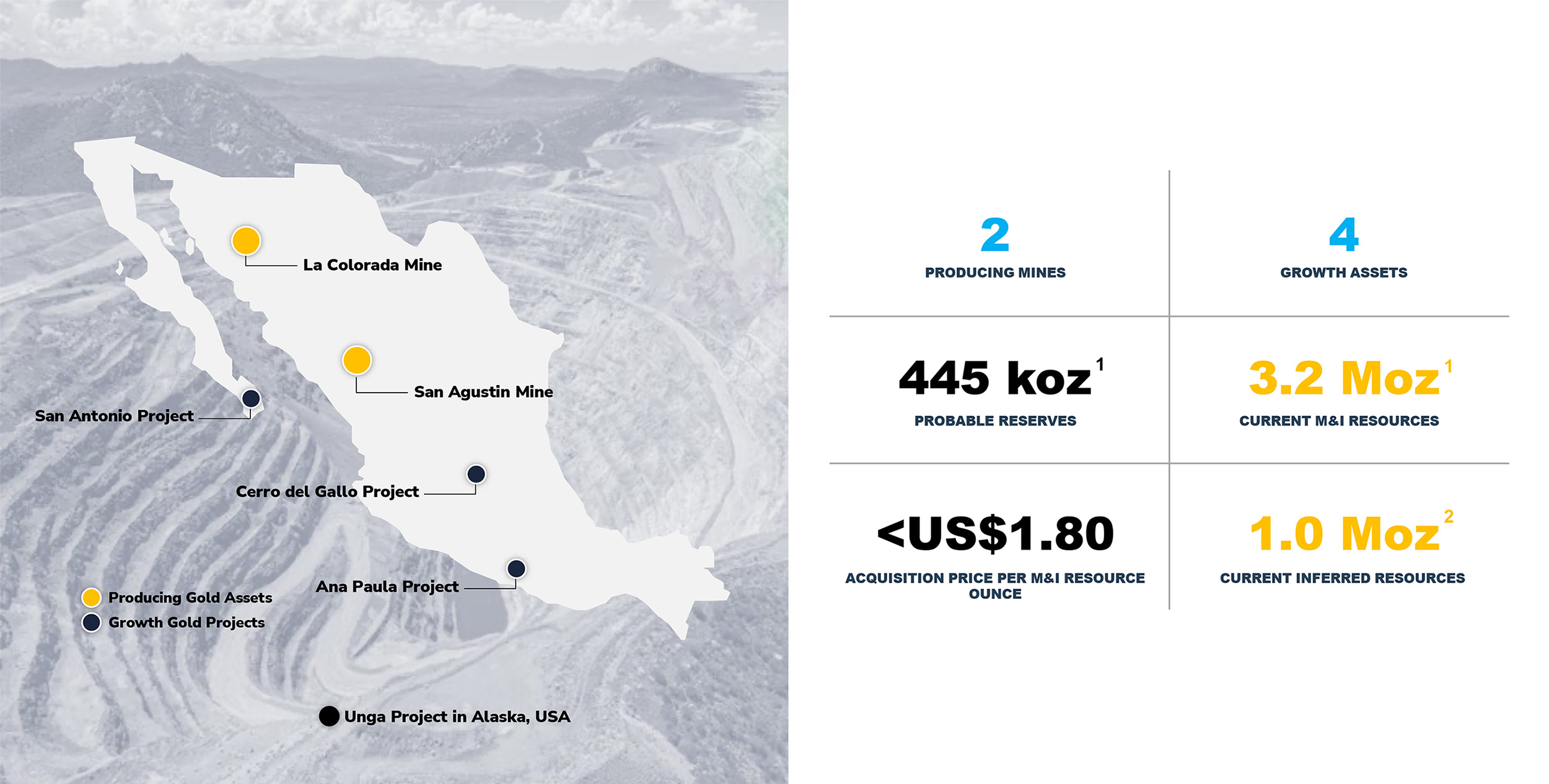
Reaching Ana Paula: easier than expected
Reaching the Ana Paula project was surprisingly easy. Upon landing in Mexico City – which of course is a major international and intercontinental airport – the Ana Paula project site could be reached within five hours by car (of which at least an hour is spent in the horrible traffic trying to leave Mexico City), on paved roads. While those paved roads are of course a bit rougher than most North American or European highways, it was surprisingly easy to get into Guerrero and reach the project site where we were toured by CEO Charles Funk, COO Gregg Bush and VP Sustainability Hernan Dorado. VP Corporate Development Mike Gingles and Chairman Jacques Vaillancourt were also present.





Heliostar Metals inherited the camp from the previous operators (as this of course was included in the acquisition of Ana Paula from Argonaut Gold) and we were pleasantly surprised by the on-site accommodation. All rooms in the barracks were spacious and clean with a small en-suite bathroom, power plugs and AC. A modern camp with all basic necessities present on-site.



The camp is also located conveniently close to the ‘hotspots’ of the project. The entrance of the decline is just a short hike away, while the drill rigs that were completing the 5,000 meter drill program while we were on site were easily accessible as well. The company has been releasing assay results from the Ana Paula deposit in the past few weeks and months, and we will discuss these later in this report.









The core shack is located on the outskirts of a nearby village and as the photos show, the core shack is a clean and well-maintained facility that hosts the almost 150,000 meters of drill core that has been completed at Ana Paula by Goldcorp (3,689 meters in 2005), Newstrike Capital (111,627 meters drilled between 2010 and 2014) and Alio Gold (27,127 meters drilled between 2015 and 2018) as well as the most recent holes drilled by Heliostar Metals.












An overview of Ana Paula
The Ana Paula project is located in the northern part of the State of Guerrero in Mexico, approximately halfway between Mexico City and Acapulco. That state still has a pretty bad reputation as it was one of the most violent states in Mexico with drug-related kidnappings and murders happening on a regular basis. This meant Guerrero was a ‘no go’ zone for most Western companies for a long period and the amount of Western companies that successfully operated in Guerrero can be counted on one hand.
Fortunately the situation appears to have improved and perhaps the best example of indicating it is possible to work in Guerrero is Torex Gold (TXG.TO), Heliostar’s neighbour. Their nearby Los Morelos mine is operating as expected and Torex recently completed a very substantial investment to keep the mine humming along nicely (Morelos produced in excess of 450,000 ounces of gold in 2024). It appears that Guerrero is ‘workable’ and we would describe the current situation as a ‘live and let live’ situation.
The negative perception surrounding Guerrero allowed Heliostar to pick up the Ana Paula asset for a song and since entering into the agreement to acquire full ownership of Ana Paula (and until the Mexican assets of Argonaut Gold were acquired) Heliostar was a call option on A) improving safety in Guerrero and B) improving the Ana Paula project by adding ounces and focusing on the high-grade zones which host the majority of the gold. CEO Charles Funk and his team decided the best way to advance Ana Paula was by focusing on the underground zones which could be accessed through a decline which is already half-built.
Earlier this year, the company released the assay results from five holes that were drilled as part of the 2024 drill program. An initial 2,600 meters is focusing on extending the high grade panel and parallel panels to the west, drill-testing the down-dip extension of the High Grade Panel and complete some infill holes at the Parallel Panel. On top of that, two holes are designed to intersect the potential mine stopes to collect metallurgical samples for the feasibility study.
Hole AP-24-313 was the largest step-out hole, and aimed to connect a deeper zone of higher grade gold mineralization. This hole was a success as the drill bit intersected just over 6 meters of 8.24 g/t gold. This could indicate the size of the High Grade Panel could be expanded by over 115 meters further down plunge.

Hole AP-24-314 was even more intriguing as it defined a new zone of gold mineralization in between the High Grade Panel and the Parallel Panel. More drilling will be needed to figure out the full extent of the mineralization, after the company encountered 16 meters of 16.7 g/t gold.
Those excellent first results were followed up on in December with what might very well become the best hole of the campaign. Heliostar released the assay results from three more holes that were drilled as part of its 2024 drill program at Ana Paula. The purpose of the two holes the company reported on was to expand the high-grade panel, and given the spectacular mineralized intervals it’s fair to say the company clearly succeeded as all three holes intersected high-grade mineralization. The 4.02 g/t encountered in hole AP-24-315 isn’t the highest grade but encountering that grade over an interval of in excess of 125 meters is excellent. And keep in mind it includes just over 23.5 meters of 12.5 g/t gold as well.
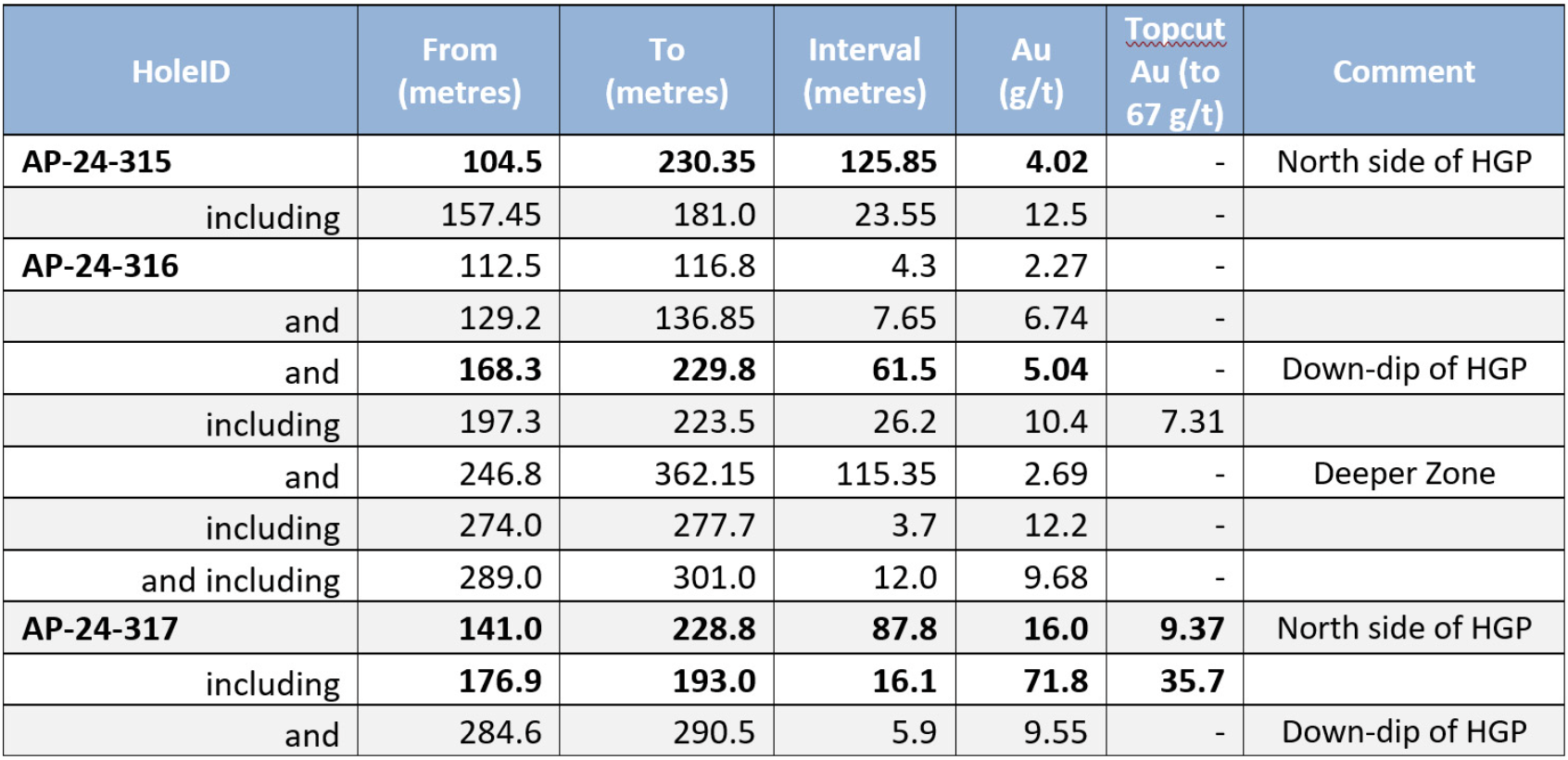
Hole 316 intersected the zone down dip of the high-grade panel with 61.5 meters containing 5.04 g/t gold but even more interesting is the fact that this hole intersected a deeper zone with a pretty thick interval of 115.35 meters containing 2.69 g/t gold. Again, 2.69 g/t gold isn’t high but applying a recovery rate of 80% implies a recoverable rock value of almost US$175/t at $2500 gold.
The real eye-catcher was hole AP-24-317 where visible gold was detected in the core. The assay results didn’t disappoint either as the drill bit intersected almost 88 meters of 16 g/t gold, including 16.1 meters of 71.8 g/t gold (which was capped at 35.7 g/t gold using a cap of 67 g/t gold).
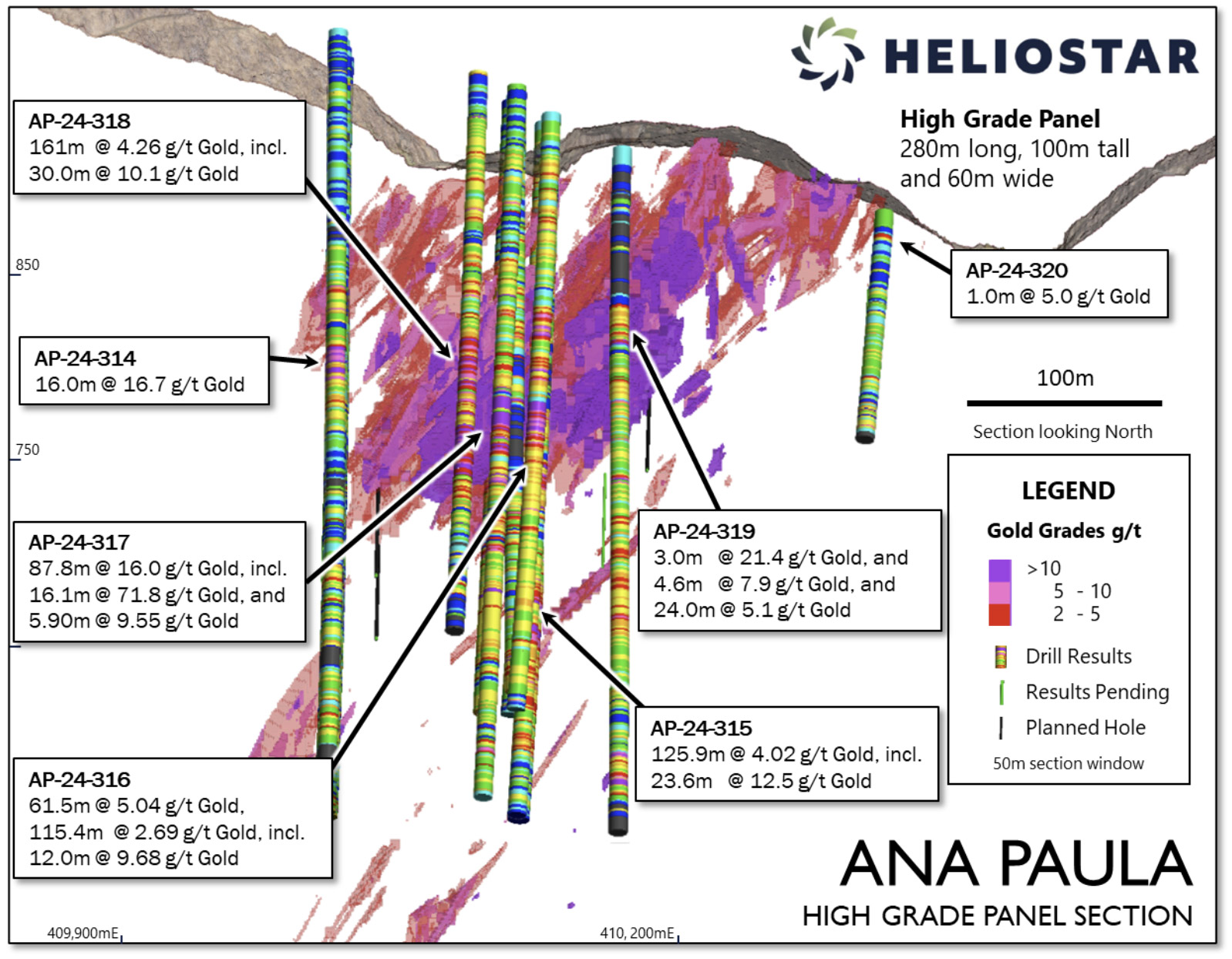
These three holes indicate the high-grade panel is growing down-dip and towards the north while the grades that were encountered are – in some locations – higher than the grade in the resource model. In his comments, CEO Charles Funk mentions the 2024 drill results suggest the conversion of inferred resources into a measured and indicated resource category could result in higher gold grades as well.
In a more recent update, Heliostar released additional assay results from its Phase One drill program at the fully-owned Ana Paula project in Mexico’s Guerrero state.
The four holes the company reported on late last month were designed to expand the high grade panel at Ana Paula while some of the holes were also targeting step-out targets at depth. The company summarized the results of the four holes in the bullet points below:
- Hole AP-24-318 shows a 161-metre-long interval of consistent gold mineralization grading 4.26 g/t gold from 101 metres downhole with multiple higher-grade subzones, including 30 metres grading 10.1 g/t gold.
- Hole AP-24-321 intersected a zone of limestone to the north of hole AP-24-317, which intersected an interval of 87.8 metres grading 16.0 g/t gold. At the upper contact of this limestone, hole AP-24-321 encountered 15.7 metres grading 10.4 g/t gold from 167.6 metres downhole. This suggests that the very high grades in AP-24-317 are due to gold concentrating along a geological contact.
- Hole AP-24-321 also intercepted a deeper interval of 13 metres grading 3.5 g/t gold from 327 metres downhole that may be a narrow depth extension beneath the High Grade Panel.
- Hole AP-24-319 is, we believe, perhaps the most interesting of today’s results. It was the first north to south hole on a new cross-section through the deposit and hit multiple gold zones. It intersected 3 metres grading 21.4 g/t gold from 111 metres downhole in a step down in the Parallel Panel. Beneath the High Grade Panel, it returned a best intercept of 4.6 metres grading 7.9 g/t gold from 189 metres downhole amongst multiple narrow intercepts. These zones suggest good potential to extend the High Grade Panel deeper than currently modelled on this section.
- Further downhole again in AP-24-319, a broad satellite zone over 150 metres beneath the High Grade Panel with 24 metres grading 5.1 g/t gold from 349 metres downhole has room to expand above and below the drillhole.
- Hole AP-24-320 was drilled to the east of the High Grade Panel and returned 1.0 metres grading 5.0 g/t gold from 102 metres downhole.
We concur with the company’s assessment that hole 319 is the most interesting of the holes Heliostar reported on. Not just because of the location but also because the drill bit intersected multiple separate areas of mineralization. As the table below shows, the drill bit intersected numerous intervals of 3-5 meters with elevated gold values. 3 meters of 21.4 g/t from 111 meters downhole, followed by 4.6 meters of 7.91 g/t gold from 189 meters and 3 meters of 10.9 g/t gold from 349 meters down-hole.
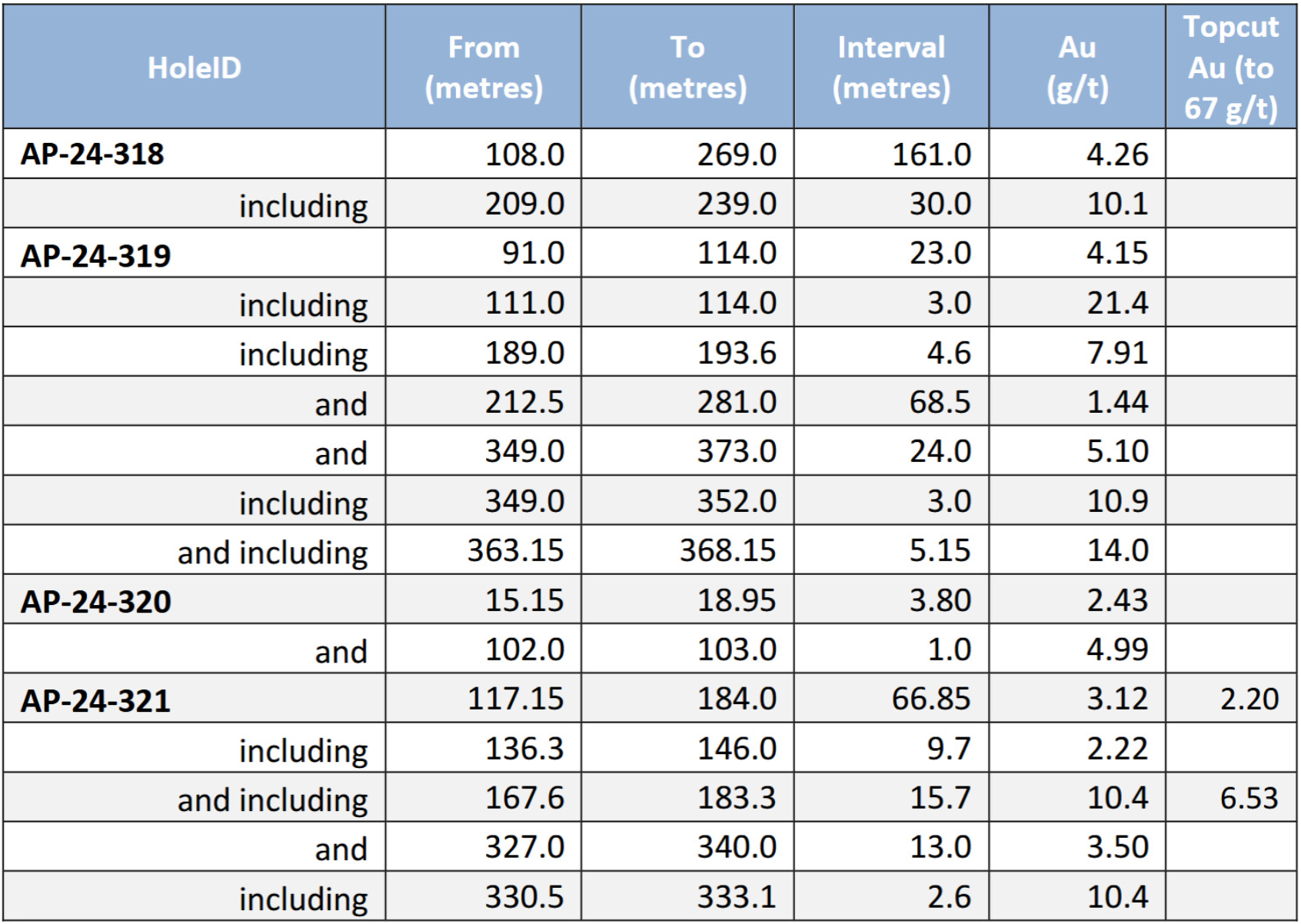
As part of its Phase One drill program, Heliostar Metals has already completed nine holes for a total of just over 3,200 meters. The best (or most interesting) results from Phase One will be followed up on in a Phase Two program later this year.









Where will we go from here?
With the results of the 2024 drill program are in, we may expect to see an updated resource in combination with the feasibility study, which should be published by the end of this year. While Heliostar of course can only put its third party consultants to work when all assay results have been received, the company has announced its expectations.
In general, Heliostar Mining would like to grow the shallow part of the Ana Paula deposit to a total size of 1.5-2 million ounces. While we aren’t counting on Heliostar reaching the upper part of that guidance considering it drilled just 5,000 meters last year, it is encouraging to see the company being so outspoken about its targets.
Heliostar expects to add about 200,000 ounces of gold from the high-grade panel with an additional 100,000-300,000 ounces of gold that could be sourced from the parallel zone. As Ana Paula currently hosts 711,000 ounces of gold in the measured and indicated resource categories and almost 450,000 ounces of gold in the inferred resource category, growing this resource towards 1.5 million ounces across all categories sounds achievable. We expect this to be just an interim update. As the image below shows, drilling has intersected high-grade gold mineralization at depth and we expect the company to try to connect the dots further down the road.
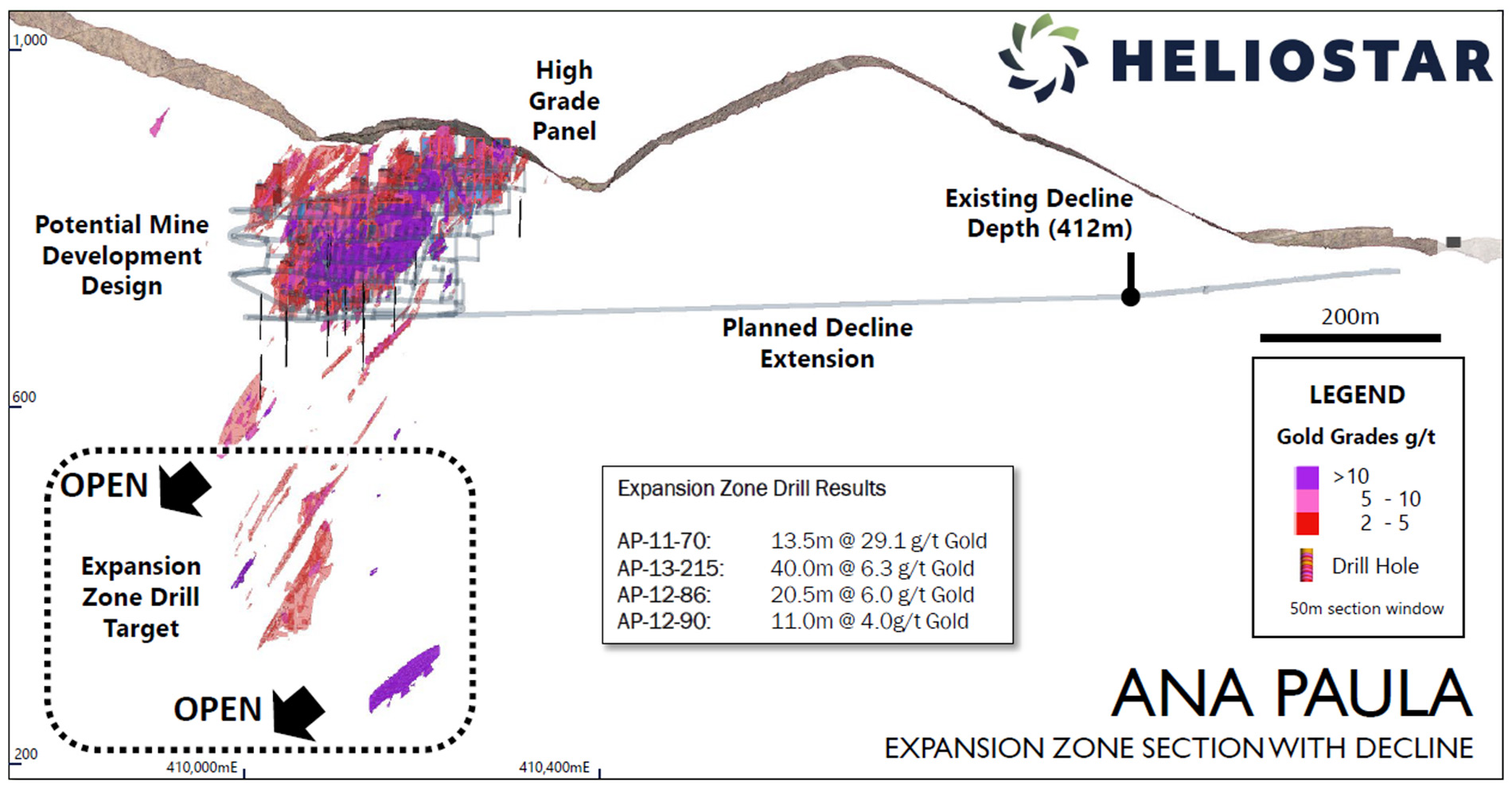
That being said, this would ideally be funded by cash flow from Ana Paula to replenish the resources (and reserves once a feasibility study has been completed) as the market likely won’t care too much whether the next resource update comes in at 1.5 million ounces or 2 million ounces. Heliostar likely won’t get any additional value for an additional half million ounces at this stage, so it makes little sense to pursue a resource expansion at depth. Additionally, drilling will be easier and cheaper using underground drill stations which can be put in place once the decline has been completed.
A larger resource estimate should also be helpful to prove the superior economics of Ana Paula in the feasibility study.
We are also looking forward to seeing the updated results of additional metallurgical test work. As you may remember, the primary sulphide minerals at Ana Paula are arsenopyrite and pyrite and recovery rates. The deposit has also been domained into a high-recovery and lower-recovery zones with the higher recovery zones being dominated by free gold while the lower recovery domain is dominated by solid solution in arsenopyrite.
While test work is ongoing, CEO Gregg Bush – who is a metallurgist by trade – expects to reach a gold recovery rate of approximately (and hopefully exceeding) 80% using a combination of flotation and CIL. Given the current high gold price we expect the company to have a look at using a BIOX process as well and this will allow Heliostar to make an informed decision ahead of the feasibility study at Ana Paula. Every 1% increase in the anticipated recovery rates will add 10,000 ounces of recovered gold (and thus US$25-28M in pre-tax cash flow) per million ounces included in the mine plan. Needless to say a 2-3% boost in the recovery rates could have a very noticeable impact on the project economics.
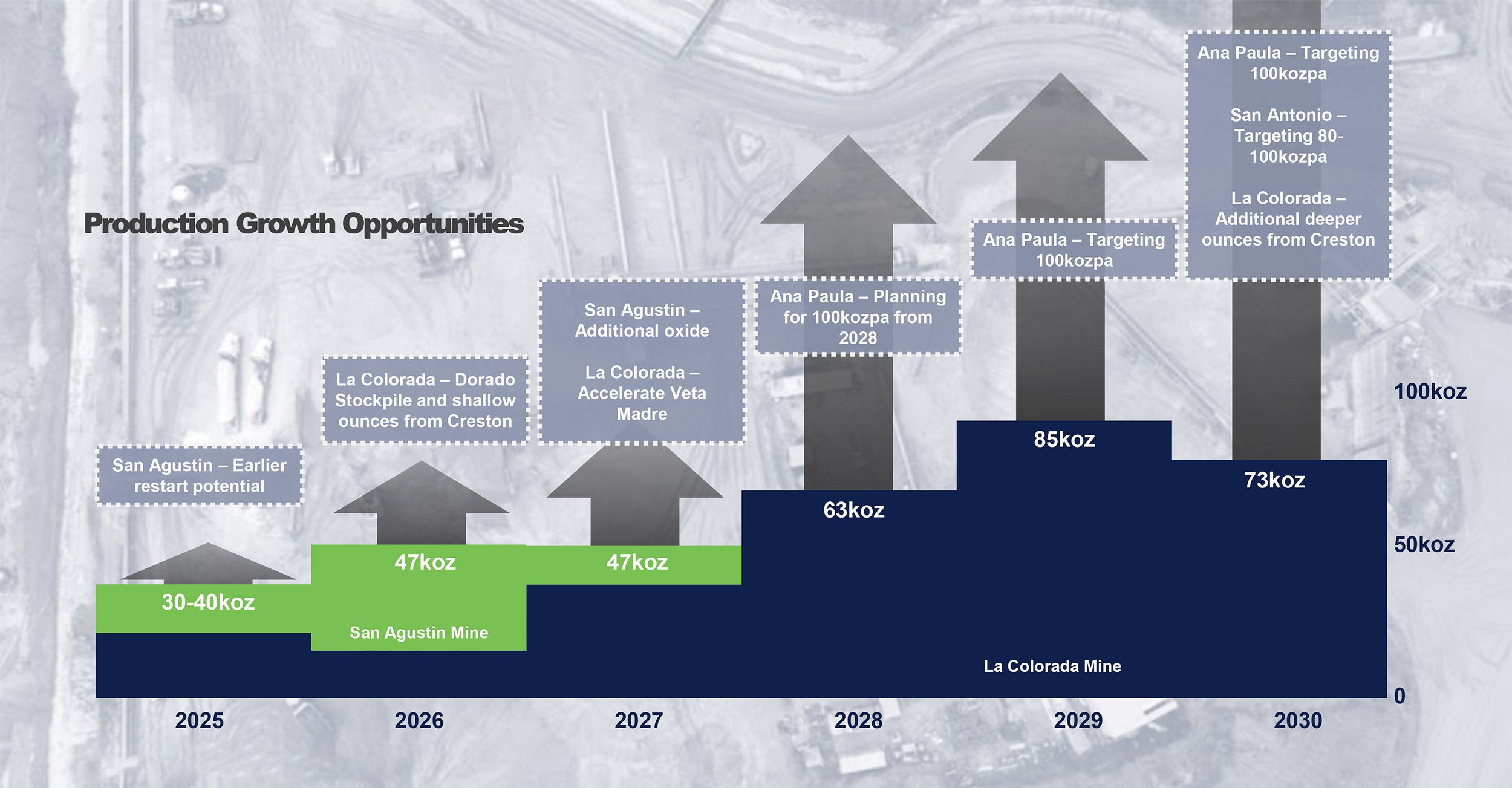
Conclusion
This site visit report on Ana Paula is just the first part of our tour through Mexico with CEO Charles Funk and Chairman Jacques Vaillancourt and our next update will dig deeper into the newly-acquired La Colorada and San Agustin mines and Heliostar’s production plans for 2025 and beyond.
We walked away from the Ana Paula project impressed with the existing camp facilities and the very strong knowledge of the technical team with COO Gregg Bush spearheading the efforts to crack the metallurgical code at Ana Paula.
Disclosure: The author has a small long position in Heliostar Metals. Heliostar Metals is a sponsor of the website. Please read our disclaimer.
